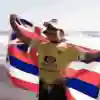
Anyone who's been in the lineup has heard your infectious giggle. Every day is not easy and you've been through a lot, but where does your ability to laugh through hard times come from?
I think that started with the Coast Guard. I can't tell you how many times I heard the comment, 'You're too happy. Get ready for this to tear you down and make you miserable'. I thought, ‘Okay, challenge accepted'. I decided that even if I was miserable, I wouldn't let people see that. I wanted to prove them wrong.
I think with getting in the water, that was always the space where I released all of my angst. And if I’m feeling joy, I gave myself permission to focus on what's going on in front of me, so I naturally laugh in the lineup. I've always felt like I'm lighter in the water, even in intense situations. I find there's that part of me that freaks out and thinks, ‘Oh no, what is about to explode in front of me?' But you have two or three seconds – which can feel like an eternity – to think, 'Okay, this is all about to hit the fan, what can I do right now?' Having that go through your head, to calm yourself down and to almost lean into getting obliterated feels triumphant.
Earning my spot came down to people seeing me a lot, consistently being there, showing that I wanted it and going out in all conditions
How has your journey been to earning your spot in the front row of the photography lineup at Pipeline?
The first time I went out to Pipe was on a two to three foot day in late 2014. I still remember seeing my first barrel out there and thinking it was huge! In 2015, while photographing the Backdoor Shootout, I remember accidentally getting in front of Erik Ippel’s shot and he yelled at me. I thought, ‘Oh shit, I messed up'. After I swam out of the way, I realised that I appreciated that he didn’t give me special treatment because I was the only woman. Earning my spot came down to people seeing me a lot, consistently being there, showing that I wanted it and going out in all conditions. I was always trying to be respectful of the guys that were already there and very established. I sat in the back for a number of seasons and worked my way up the pecking order.
Is shooting Pipeline scary for you?
Yeah, I definitely feel fear out there. You can get seriously injured or worse in a matter of seconds. But if you're so focused on that and tensing up, that's not gonna serve you at all. That's just going to waste your oxygen, especially if you're under the water getting tossed around. The more relaxed you can make yourself, the higher chances you have of surviving or being less injured when all's said and done.
How do you maintain being relaxed while holding onto a heavy water housing?
You start by shooting on small days and work your way up. It's exciting when you're in the right spot for a wave and it's easy to mess up a shot if you get too hyped. When I see a wave coming in that I'm about to shoot, I take a deep breath and then fire the shutter. That technique keeps me relaxed. The same rule to start on less consequential days applies to not letting go of your housing when you're getting worked. By going out on easier days, you can learn where your camera is in relation to your body. Then, when you're in heavier situations, you can apply what you've learned, so you're less likely to break your housing when you hit the bottom.
Do you hug the camera into you when you're diving under a big wave?
Sometimes, it depends on the situation. When I hug it, I lock it in so it won't rear up and hit me in the face. You almost give it a bear hug. That's what Larry (Haynes) recommended: "bear hug your camera real tight and hope for the best."
Iconic cinematographer Larry Haynes was a mentor. How did he impact your shooting career?
When he was shooting or whatever he was doing, he was just genuinely happy and stoked to be there. That attitude was something that I really aim to emulate. I had a great time shooting with Larry. His stories were amazing, because he'd get so animated telling them. When we were shooting together, I found myself watching what he was doing and where he would sit. He would always just sneak in pieces of advice to me like, 'this is the boil that I sit on when I want to shoot this section of the wave'. When he'd drop those nuggets, I'd mentally take notes.
The last contest you and Larry shot together was the 2023 Eddie Aikau Invitational. You were the first woman to ever shoot photos from the lineup during that event and you swam for the entire eight hours. Looking back on it now, how was your Eddie experience?
That day was absolutely insane. It meant so much to me and the other photographers to be shooting with Larry that day. Abe Lerner was driving him on the ski. We all loved shooting with him in the water or while he was on the ski with Abe. His last Eddie is a memory we'll all hold onto.
Being there swimming with Keoki Saguibo, Mike Ito, John Hook, and Larry, it felt like we all had each others back and our communication with each other was key. We all just did our best to maintain our position as closeout sets approached. Many of the best rides came from waves before the closeouts. Managing those sets while shooting was big game of cat and mouse. If we weren’t all looking out for each other it would have been a lot scarier. My adrenaline was turned up to 12, I was thinking, ‘holy ****!!’, for an entire day.
How deep did you have to dive under those closeout waves at Waimea?
I don't have a number for how deep I'd have to go, it depended on what the closeout looked like. I'd swim down and keep going down, and if I needed to equalise my ears, I'd do that. A lot of what I'm doing underwater is by feel, because I keep my eyes shut so my contacts don’t come out. When I was ready to swim up, I'd wait until it seemed like it was a good time, hoping for the best. There were instances where I swam up too quickly and an eddy swirling in the whitewater would suck me back down. My goal was to minimise the amount of turbulence I had to deal with and when that wasn't an option, it was chaotic. I took the whole day wave-by-wave.
How do you prepare for an event like that?
There was a day in 2021 that was Eddie sized, but they didn't run the Eddie event because of Covid. They ended up running the women's Red Bull Magnitude event that day instead, which I shot from the water. A lot of the women were surfing and charging. It was massive and closing out the Bay.
Swimming and shooting that day helped me understand where I needed to position myself and what lens to use at that size. I also figured out how the housing I was using reacted after swimming under closeouts and what I needed to do to prevent leaks. Having to deal with the conditions throughout that day helped me build my confidence. So, when the Eddie came around in 2023, I had those experiences to lean on.
You recently shot the 2024 Eddie Aikau from the water. Was it easier than the year before and less scary?
I can’t believe that we had another Eddie so close to the previous one and how hard the surfers were pushing it. I'm incredibly grateful to the Aikau Family for continuing to let me be part of this celebration of Hawaiian culture.
The 2023 and 2024 Eddie were different, but it’s hard to compare the two because I don't want to take anything away from either of them. 2023's Eddie was unbelievably consistent, there was at least one closeout set an hour and it grew in size the entire day. 2024's Eddie seemed to have more rideable waves and fewer closeouts. Both were intense, dangerous and had my adrenaline pumping, though. I was scared in different ways for each of them. Anything 20 feet and over at Waimea is on another level. The challenge for me during both was shooting images that do justice to what the rider is experiencing. The main lesson I took from the 2023 Eddie that helped me in 2024 was knowing what to expect with how I'd feel the days leading up to the event, the day of and the come down after.
Do you have a favorite moment from shooting the 2024 Eddie ?
Ben Wilkinson air dropped into a wave that no one caught from deep. I was inside of him when he whipped around to go for the wave, I shifted my camera lens to the widest setting and captured one of my favorite photos from the event. Ben has been on the alternate list for a number of years and I was so excited to be able to give him photos from the first Eddie he had the opportunity to participate in.
Has there ever been a time where you haven't gone out because you didn't think you get out and then get in again?
Oh yeah! If I don't think I can make the swim out or the swim in, I'm not going. That doesn't always mean it’s an easy decision, but if I’m not capable of either one of those, I shouldn't be in the water. There have been maxed out days at Pipeline where the current made swimming look impossible. I remember one afternoon I was watching the waves by the Ehukai lifeguard tower trying to decide if I should swim or not. Tamayo Perry was on duty and he broke down the conditions. He didn't directly say don't swim out, but he gave me all the context I needed to understand that I shouldn't go. Tamayo also reminded me that winter is a marathon, not a sprint.












.png)
